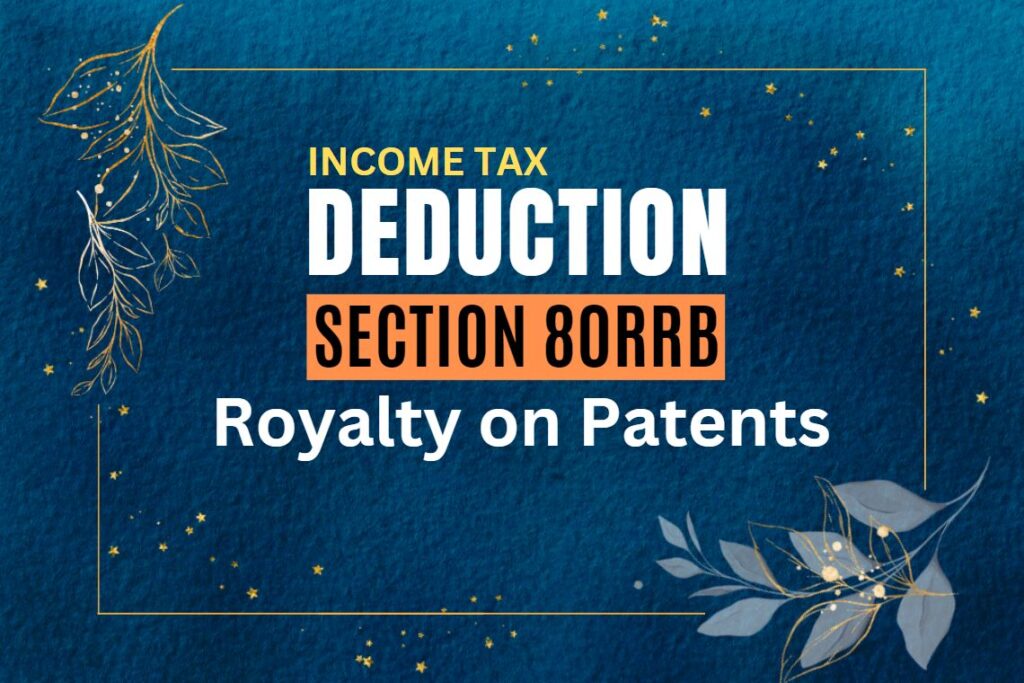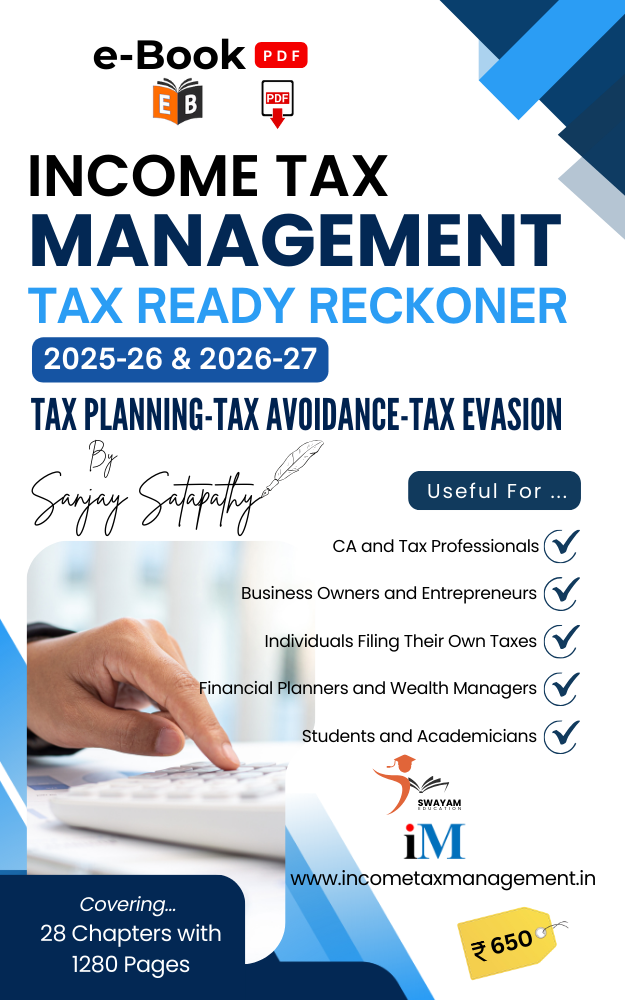1. Introduction to Section 80CCD
Section 80CCD of the Indian Income Tax Act, 1961, provides for deductions in respect of contributions made to the National Pension Scheme (NPS). This section encourages individuals to save for their retirement by offering tax benefits on contributions to the NPS.
Here are the key details of Section 80CCD:
(1) Eligibility:
Both individual taxpayers and employees can claim deductions under Section 80CCD for contributions made to the NPS.
(2) Types of Contributions:
(i) Employee’s Contribution (Section 80CCD(1) :
This sub-section allows individuals and HUFs to claim a deduction of up to Rs 1.5 lakh per year for contributions made to the NPS. This deduction is in addition to the deduction that can be claimed under Section 80C.
(ii) Employer’s Contribution (Section 80CCD(2):
This sub-section allows employers to claim a deduction for contributions made to the NPS on behalf of their employees. The deduction is limited to 10% of the employee’s salary (basic + dearness allowance).
(iii) Additional Self-Contribution (Section 80CCD(1B):
An additional deduction of up to Rs. 50,000 is available under Section 80CCD(1B) for contributions made by an individual taxpayer to their NPS account.
(3) Deduction Limit:
For employee’s contribution (Section 80CCD(1)), the deduction is limited to a maximum of 10% of the individual’s salary (basic plus dearness allowance) or 20% of gross total income in the case of self-employed individuals.
For employer’s contribution (Section 80CCD(2)), there is no specific limit, but the total contribution cannot exceed 10% of the employee’s salary.
The additional self-contribution (Section 80CCD(1B)) is limited to a maximum of Rs. 50,000.
(4) Aggregate Limit:
The aggregate of deductions under Section 80CCD(1) and Section 80CCD(1B) cannot exceed Rs. 1.5 lakh in a financial year. However, Section 80CCD(2) does not fall under this aggregate limit.
(5) Withdrawal:
While contributions to the NPS enjoy tax benefits, it’s important to note that withdrawals from the NPS are taxable, and the tax treatment may vary based on the type of account and the timing of withdrawals.
(6) Tier-I and Tier-II Accounts:
The NPS has two types of accounts, Tier-I and Tier-II. While contributions to the Tier-I account are eligible for deductions and offer tax benefits, the Tier-II account does not provide tax benefits and allows for more flexible withdrawals.
(7) Lock-in Period:
Contributions to the Tier-I account have a lock-in period, and partial withdrawals are allowed under specific conditions.
(8) Nomination:
NPS account holders should nominate beneficiaries to receive the accumulated pension wealth in case of their demise.
It’s important for taxpayers to understand the specific rules and conditions governing the NPS and the deductions under Section 80CCD to effectively plan for retirement and take advantage of the tax benefits offered by the scheme.
(2) Deduction of an Employee‘s / Assessee’ s Contribution made towards the National Pension Scheme (NPS) [Section 80CCD(1)]:
Section 80CCD(1) of the Indian Income Tax Act, 1961, allows for the deduction of an employee’s or Assessee’ s contribution made towards the National Pension Scheme (NPS). This section encourages individuals to save for their retirement by offering tax benefits on their own contributions to the NPS. Here are the key details regarding Section 80CCD(1):
Eligibility:
This deduction is available to both salaried individuals and self-employed individuals.
Deduction Limit:
The deduction allowed under Section 80CCD(1) is limited to a maximum of 10% of the individual’s salary (basic salary plus dearness allowance) for salaried individuals or 20% of the gross total income for self-employed individuals. However, this limit is subject to a cap of Rs. 1.5 lakh under Section 80CCE, which includes various other deductions such as Section 80C, Section 80CCC, and Section 80CCD(1).
Calculation
Deduction = Minimum of the following:
* Amount of contribution made to the NPS during the financial year
* Rs 1.5 lakh
For example, if you contribute Rs 1 lakh to the NPS during the financial year, you can claim a deduction of Rs 1 lakh under Section 80CCD(1). If you contribute Rs 1.75 lakh to the NPS during the financial year, you can only claim a deduction of Rs 1.5 lakh under Section 80CCD(1).
Additional Deduction:
In addition to the limit specified in Section 80CCD(1), individuals can also claim an additional deduction of up to Rs. 50,000 under Section 80CCD(1B) for contributions made to the NPS.
Aggregate Limit:
The aggregate of deductions under Section 80C, Section 80CCC, Section 80CCD(1), and Section 80CCD(1B) cannot exceed Rs. 1.5 lakh in a financial year.
Types of NPS Accounts:
The deduction is applicable to contributions made to the Tier-I NPS account, which has certain restrictions on withdrawals and a lock-in period.
Timing of Deduction:
The deduction can be claimed in the year in which the contribution is made. For example, if you contribute to your NPS account during the financial year 2022-23, you can claim the deduction for that contribution while filing your income tax return for the assessment year 2023-24.
Form 10-CCB:
To claim the deduction under Section 80CCD(1), you need to submit Form 10-CCB to your employer, who will then consider this deduction while calculating your taxable income and withholding tax.
Nomination:
It is advisable to nominate a beneficiary who will receive the accumulated pension wealth in the event of the contributor’s demise.
In summary, Section 80CCD(1) allows individuals to claim a deduction for their own contributions to the NPS, subject to certain limits. This deduction encourages individuals to plan for their retirement and provides a tax benefit for doing so. It’s essential for taxpayers to understand the rules and conditions associated with NPS contributions and deductions to make informed financial decisions and minimize their tax liability.
(3) Deduction of Rs.50,000 under section 80CCD(1B):
Section 80CCD(1B) of the Indian Income Tax Act, 1961, provides an additional deduction of up to Rs. 50,000 for contributions made to the National Pension Scheme (NPS) by an individual taxpayer. This deduction is in addition to the deductions available under Section 80CCD(1) and is aimed at encouraging individuals to save more for their retirement. Here are the key details regarding Section 80CCD(1B):
To claim a deduction under Section 80CCD(1B), you must meet the following conditions:
- You must be an individual or a Hindu Undivided Family (HUF).
- You must be a citizen of India or a resident of India.
- You must have made a contribution to the NPS during the financial year.
The deduction is calculated on the basis of the lower of the following two amounts:
- The amount of contribution made to the NPS during the financial year.
- Rs 50,000.
For example, if you contribute Rs 1 lakh to the NPS during the financial year, you can claim a deduction of Rs 50,000 under Section 80CCD(1B). If you contribute Rs 2 lakh to the NPS during the financial year, you can only claim a deduction of Rs 50,000 under Section 80CCD(1B).
To claim the deduction under Section 80CCD(1B), you must file your income tax return for the financial year in which you made the contribution to the NPS. You must attach a copy of your NPS statement to your income tax return.
Eligibility:
This deduction is available to both salaried and self-employed individuals who contribute to the NPS Tier-I account.
Maximum Deduction:
Taxpayers can claim a deduction of up to Rs. 50,000 per financial year under Section 80CCD(1B). This deduction is over and above the deductions available under Section 80CCD(1).
Aggregate Limit:
The total aggregate deduction under Section 80CCD(1) and Section 80CCD(1B) cannot exceed Rs. 1.5 lakh in a financial year. This limit is specified under Section 80CCE, which includes various other deductions like Section 80C, Section 80CCC, and Section 80CCD.
Contributions:
To claim this deduction, individuals need to make contributions to their NPS Tier-I account. The contributions can be made regularly or as lump-sum payments.
Timing of Deduction:
The deduction can be claimed in the year in which the contribution is made. For example, if you contribute to your NPS account during the financial year 2022-23, you can claim the deduction for that contribution while filing your income tax return for the assessment year 2023-24.
Form 10-CCB:
To claim the deduction under Section 80CCD(1B), you need to specify the contribution amount in Form 10-CCB while filing your income tax return. You do not need to submit this form to your employer.
Lock-in Period:
Contributions made under Section 80CCD(1B) are subject to the same lock-in conditions as those made under Section 80CCD(1). This means that the money saved in your NPS account is intended for retirement, and there are restrictions on withdrawing it prematurely.
Nomination:
It is advisable to nominate a beneficiary who will receive the accumulated pension wealth in the event of the contributor’s demise.
Section 80CCD(1B) provides an additional incentive for individuals to save for their retirement by offering a deduction of up to Rs. 50,000 on contributions to the NPS Tier-I account. Taxpayers should carefully consider this deduction as part of their tax planning and retirement savings strategy.
(4) Deduction of Employer’s Contribution [Section 80CCD(2)]:
Section 80CCD(2) of the Income Tax Act, 1961 allows salaried employees to claim a deduction for the employer’s contribution to the National Pension System (NPS) up to 10% of their salary (basic pay and dearness allowance). The deduction is available over and above the limit of Rs. 1.5 lakh under Section 80C and Rs. 50,000 under Section 80CCD(1B).
What is Section 80CCD(2)?
Section 80CCD(2) of the Income Tax Act allows individuals to claim a deduction on the employer’s contribution to their National Pension Scheme (NPS) account. This provision is applicable to both salaried and self-employed individuals who contribute to the NPS.
Under this section, the maximum deduction that can be claimed is 10% of the individual’s salary or gross income, whichever is lower. However, there is no upper limit on the amount that can be contributed by the employer.
Conditions for claiming deduction under Section 80CCD(2)
In order to claim the deduction under Section 80CCD(2), certain conditions need to be fulfilled:
- The individual must be a contributor to the NPS.
- The contribution must be made by the employer on behalf of the employee.
- The maximum deduction allowed is 10% of the employee’s salary or gross income, whichever is lower.
Steps to Calculate the Deduction of Employer’s Contribution:
- Calculate your total salary, which is your basic pay and dearness allowance.
- Multiply your total salary by 10% to calculate the maximum deduction of employer’s contribution.
- Compare the maximum deduction of employer’s contribution to the actual employer’s contribution. The lower amount is the actual deduction.
Example:
Let’s say your basic salary is Rs. 100,000 and your dearness allowance is Rs. 20,000. Your total salary is Rs. 120,000.
The maximum deduction of employer’s contribution is Rs. 120,000 * 10% = Rs. 12,000.
Let’s say your employer contributes Rs. 10,000 to your NPS account. The actual deduction of employer’s contribution is Rs. 10,000, which is lower than the maximum deduction.
Note:
- The deduction of employer’s contribution is available to both central government and state government employees.
- The deduction is also available to private sector employees.
- The deduction is available only if the employer contributes to the employee’s NPS account.
- There is no monetary ceiling on the deduction of employer’s contribution.
Advantages of claiming deduction under Section 80CCD(2)
There are several advantages of claiming the deduction under Section 80CCD(2):
Tax Savings:
By claiming this deduction, individuals can effectively reduce their taxable income. This results in lower tax liability and increased savings.
Additional Retirement Savings:
The employer’s contribution to the NPS account acts as an additional retirement savings for the employee. This can help individuals build a substantial corpus for their post-retirement years.
Long-Term Wealth Creation:
NPS offers the option to invest in various asset classes such as equities, corporate bonds, and government securities. By availing the deduction under Section 80CCD(2), individuals can benefit from the potential long-term wealth creation opportunities offered by these investment options.
(5) Taxability of amount received from Pension Scheme [Section 80CCD(3)]:
Section 80CCD(3) allows individuals to claim an additional tax deduction on the amount contributed towards their pension scheme. The deduction is available to both salaried employees and self-employed individuals. However, it is important to note that the taxability of the amount received depends on the nature of the contribution and the time of withdrawal.
Contributions made by the Employee
If an employee contributes towards their pension scheme, the amount contributed is eligible for a tax deduction under Section 80CCD(1) of the Income Tax Act. This deduction is available up to a maximum of 10% of the salary (for salaried employees) or 20% of the gross total income (for self-employed individuals).
The contributions made by the employee are not taxable at the time of withdrawal. The entire amount received from the pension scheme is considered as a return of the employee’s own contribution and is therefore tax-free.
Contributions made by the Employer
Employers also contribute towards their employees’ pension scheme. These contributions are eligible for a tax deduction under Section 80CCD(2) of the Income Tax Act. The deduction is available up to 10% of the employee’s salary (for salaried employees).
However, the contributions made by the employer are taxable at the time of withdrawal. The amount received from the pension scheme is considered as income and is subject to tax as per the individual’s income tax slab rate.
Limit of Taxability of Withdrawal of the Amount
When an individual withdraws the amount from their pension scheme, the taxability depends on the nature of the contribution and the time of withdrawal.
If the employee contributes towards their pension scheme and withdraws the amount before the completion of 5 years from the date of the first contribution, the entire amount received is taxable in the year of withdrawal. The amount is added to the individual’s income and taxed as per their income tax slab rate.
On the other hand, if the employee contributes towards their pension scheme and withdraws the amount after the completion of 5 years, only 40% of the amount received is taxable in the year of withdrawal. The remaining 60% is tax-free.
It is important to note that the taxability of the amount received from a pension scheme may vary based on the individual’s specific circumstances and the provisions of the Income Tax Act. It is advisable to consult a tax professional for personalized advice.
(6) Partial withdrawal by an employee from the National Pension System Trust [Section 10(12B)]
Section 10(12B) of the Income Tax Act, 1961 provides for tax exemption on partial withdrawal by an employee from the National Pension System Trust (NPS).
Eligibility:
To be eligible for the tax exemption, the employee must meet the following conditions:
- The employee must have made contributions to the NPS for at least 3 years.
- The partial withdrawal must be made for any of the following reasons:
- For the treatment of specified illnesses of the subscriber, his/her spouse or children.
- For the education of children.
- For the marriage of children.
- To purchase a house.
- To start a new business venture.
Amount of withdrawal:
The employee can withdraw up to 25% of the total contributions made by him/her, excluding the contributions made by the employer. The withdrawal can be made in one or more installments.
Tax exemption:
The amount withdrawn up to 25% of the employee’s own contributions is exempt from tax. The remaining amount, if any, is taxable as income under the head “Salaries”.
Procedure for withdrawal:
To withdraw money from the NPS account, the employee must submit a partial withdrawal request to the Point of Presence (POP). The POP will then process the request and transfer the money to the employee’s bank account.
Example:
Let’s say an employee has made contributions to the NPS for 5 years. The total amount of contributions made by the employee is Rs. 100,000. The employee wants to withdraw Rs. 25,000 for the education of his child.
The employee is eligible for tax exemption on the entire amount withdrawn, as it is within the limit of 25% of his own contributions.
Note:
- The employee can withdraw money from the NPS account only up to 3 times during his/her entire tenure in the NPS.
- The employee cannot withdraw money from the NPS account before the age of 60, unless he/she meets one of the eligibility conditions mentioned above.
EXAMPLE:
Gross total income of R who is self-employed is Rs.5,90,000. He has deposited Rs.1,00,000 in public provident fund and Rs.1,70,000 in pension scheme of the Central Government. Compute his taxable income if:
(a) does not opt to be taxed under section 115BAC
(b) opts to be taxed under section 115BAC
SOLUTIONS :
| Does not opt to be taxed u/s 115BAC | opt to be taxed u/s 115BAC | ||
| Rs. | Rs. | Rs. | |
| Gross total Income | 5,90,000 | 5,90,000 | |
| Less : Deduction | |||
| – Under Section 80C | 1,00,000 | ||
| – Under Section 80CCD(1) Rs.1,70,000 | |||
| – But limited to 20% of Gross Total Income of Rs.5,90,000 | 1,08,000 | ||
| 2,08,000 | |||
| But limited to Rs.1,50,000 as per Section 80CCE, | 1,50,000 | ||
| Additional Deduction under Section 80CCD(1B) | 50,000 | 2,00,000 | NIL |
| Total Income | 3,90,000 | 5,90,000 |












